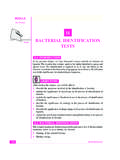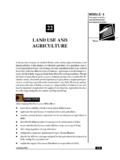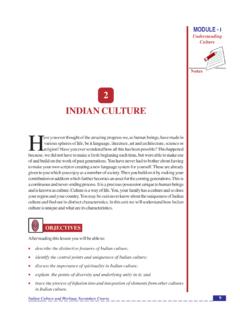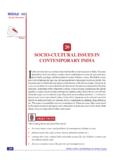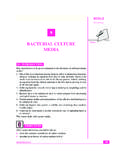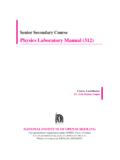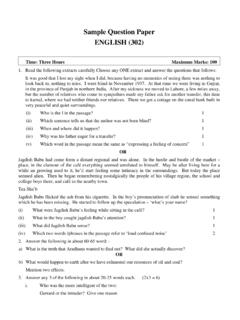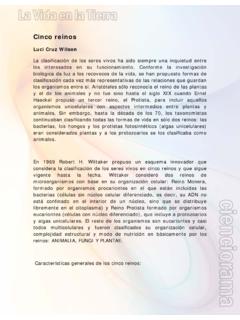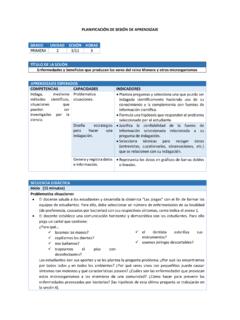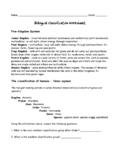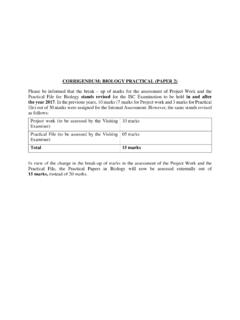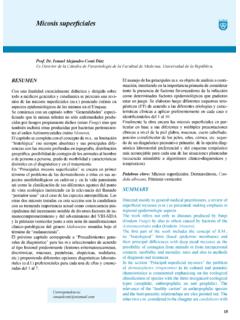Transcription of Notes THE KINGDOMS MONERA, PROTOCTISTA AND FUNGI
1 The KINGDOMS monera , PROTOCTISTA and FungiMODULE - 1 Diversity and Evolutionof Life 29 BIOLOGYN otesThe Kingdom monera which includes all the bacteria including blue-green algae(cyanobacteria) and the PROTOCTISTA which includes the protozoa, the diatoms andsome algae are in a way the simplest among the living world. All bacteria, majorityof protoctists and many FUNGI are microscopic and generally referred to as micro-organisms. You will learn about the three KINGDOMS in this completing this lesson, you will be able to :zstate the basis for classifying certain organisms as members of kingdomsMonera, PROTOCTISTA and FUNGI ;zemphasize the fact that Kingdom monera is the only prokaryotic kingdom andalso that it is the most primitive;zdescribe the generalized structure of a bacterium and cyanobacterium;zdescrible economic importance of bacteria with examples;zrecognize the status of cyanobacteria and justify its inclusion in kingdomMonera;zdescribe the characteristics of Kingdom PROTOCTISTA (protista);zdescribe the structure of Amoeba, Paramecium, Euglena and Plasmodium;zdescribe the structure of diatoms;zlist the uses of protists to humans and mention the diseases caused by protozoa.
2 Zlist the general characteristics of FUNGI with examples;zdescribe the strucutre and reproduciton of yeast, Rhizopus, mushroom, Penicilliumand its utility for humans;zexplain what are mycorrhizae;zdescribe the economic importance of KINGDOMS MONERA, PROTOCTISTA AND FUNGIThe KINGDOMS monera , PROTOCTISTA and FungiBIOLOGYMODULE - 1 Diversity and Evolutionof Life KINGDOM MONERAzIncludes the bacteria and cyanobacteria (commonly called blue-green algae).zSince only bacteria are prokaryotic (lacking a true nucleus, that is without anuclear membrane), monera is the only prokaryotic were the first cellular organisms to evolve on the planet earth after lifeoriginated around billion years ago and were the only cellular organismson earth for almost the next two billion bacteria are single celled or unicellular (monere : single) but actinomycetesand some cyanobacteria are multicellular and filamentons wherein filaments maybe are also the most numerous of all living cellular Structure of a bacterial cellThe single celled bacterium has a cell wall made of the compound peptidoglycancovering the cell membrane; and a single circular (upring-like) chromosome.
3 Thecell has ribosomes but no membrane bound organelles. Let us get to know somedetails of these parts (Fig. ).Fig. Structure of a the following parts of a bacterium in the figure (Fig. ). The outermostcovering is the cell wallAll prokaryotes have a rigid cell wall, which protects and gives shape to the cell wall is made up of a chemical, peptidoglycan, unique to bacteria, lipids,polysaccharides and some (Singular : pilus)Pili are short and thin thread like tubular structures projecting out from the cell wallin some bacteria move with the help of one or more flagella. Flagella are longer andthicker than pili. Their structure is different from flagella of MembranePlasma membrane, present below the cell wall, encloses the cytoplasm and othercell contents. It is made up of lipids and proteins, as in capsule presentin some bacteriaCell membraneCell wallVolutin phosphatecompound granulesFlagellum presentin some bacteriaRibosome granulesCytoplasmDNAnuclear materialno nuclearmembraneThe KINGDOMS monera , PROTOCTISTA and FungiMODULE - 1 Diversity and Evolutionof Life 31 BIOLOGYN otesGenetic MaterialOne circular chromosome made of a double helical molecule of DNA is located ina region of the cytoplasm called nucleoid.
4 Since the chromosome is not lodgedwithin a true nucleus, bacteria are termed as prokaryotes. Hence monera is theprokaryotic kingdom. Apart from the chromosome as several species of bacteriapossess one or more additional rings of DNA called plasmids, which replicate alongwith bacterial chromosome and bear genes for antibiotic resistance and act as thesex factor or F-factor providing the property of male sex to the cell that bears thesex-factor or the OrganellesMembrane bound organelles like endoplasmic reticulum, mitochondria, chloroplast,and golgi complex are absent. Only 70s ribosomes are present, which are differentfrom those of eukaryotes (see lesson 1 and 4).Prokaryotes have no nuclear membrane around genetic material and nomembrane bound cell organelles except mesosomes. They have only the monera - General body functionsA.
5 NutritionThe four nutritional categories found in bacteria are :(i) Autotrophs-synthesize their own organic food.(ii)Saprotrophs - feed on dead organic matter.(iii)Symbionts-use food from other living organisms with which theyare associated for mutual benefit.(iv)Parasites- absorb food from living organisms and cause harm tothemB. RespirationRespiration in bacteria may be either(i) aerobic using oxygen for respiration or(ii)anaerobic respiration in the absence of respiration or breakdown of food to release energy occurs in mesosomeswhich are the inner extensions of the cell Reproduction(i)Asexual ReproductionBacteria reproduce asexually by binary fission (Fig. ). Under favourableconditions it takes about 20 minutes for one bacterium cell to divide intotwo by binary KINGDOMS monera , PROTOCTISTA and FungiBIOLOGYMODULE - 1 Diversity and Evolutionof Life 32 NotesFig.
6 Binary Fission in Bacteria(ii)Sexual Recombination (=Genetic Recombination)Some bacteria show a primitive mode of sexual reproduction. It is differentfrom sexual reproduction in higher forms. The steps are:(a) Two conjugating (lie very close for transfer of genes) bacteria areheld together by pili.(b) A segment of DNA strand is transferred from one bacterium toanother bacterium. (Fig ) or F-factor = sex-factor (fertilistyfactor) is transferred from male donor cell to female (recipient) Conjugation in BacteriaCell wallRing of DNAC ytoplasmPlasma membraneStart of replicationof ring of DNACell continuesto grow in sizeDNA fully replicatedCell fully grownCell divides into twoThe KINGDOMS monera , PROTOCTISTA and FungiMODULE - 1 Diversity and Evolutionof Life 33 BIOLOGYN otesINTEXT QUESTIONS What is the chemical nature of the circular single chromosome of a bacterium?
7 2. Name the special region in the bacterial cell where genetic material What is the main component of cell wall in prokaryotes?..4. State one point of difference between flagella and Give one difference between aerobic and anaerobic What is transferred during sexual recombination in a bacterium?.. Beneficial and harmful bacteriaMany bacteria harm us by causing many diseases. On the other hand some bacteriaare very Caused By BacteriaName of BacteriumDisease tuberculosisTuberculosisBeneficial Activities of BacteriaName of in roots of legumes, like Peas, grams,Pulses etc, where it fixes atmosphericnitrogen as ammonia, which is then convertedinto useful amino the soil fertile. It fixes atmosphericnitrogen in the Streptomycin lactose (milk sugar) to lactic helps in setting of milk into Methanogenic bacteriaSewage treatmentThe KINGDOMS monera , PROTOCTISTA and FungiBIOLOGYMODULE - 1 Diversity and Evolutionof Life CyanobacteriaThese were earlier called the blue-green algae.
8 (Fig. ) A very successful groupon primitive earth, they could carry out photosynthesis and the oxygen releasedduring the process changed the earth s atmosphere and gradually the level of oxygenincreased in the earth s Cyanobacteria (blue green algae)Differences between Bacteria and cells1. Comparatively larger have flagella2. Do not have bacteria (green)3. They all carry out photosynthesiscarry out photosynthesis in ain the usual manner as in greendifferent way and do notplants and release oxygenrelease oxygen (anoxygenic)(oxygenic) recombination by4. Sexual recombination has beenconjugation in some bacteriaobserved in some QUESTIONS Name the bacteria that :(i) fix atmospheric nitrogen in the soil ..(ii)set milk into wallCell membranePosition of DNAS lime layerCell wallRing of DNAFood granulesRibosomeCell membraneMesosomePiliThe KINGDOMS monera , PROTOCTISTA and FungiMODULE - 1 Diversity and Evolutionof Life 35 BIOLOGYN otes(iii)cause (vi)cause Approximately how many bacteria may be obtained from one bacterium in anhour?
9 3. Give any three differences between bacteria and MoneraKingdom monera includes three groups, Archaebacteria2. Eubacteria, and3. CyanobacteriaArchaebacteria includes bacteria that live in unusual environments particularly at lowlevels of oxygen. Main types of Archaebacteria arezMethanogenic bacteria that live in sewage and intestinal tracts of animalszThermoacidophilic bacteria that live in hot bacteria which live in salty conditions where hot sun concentratessea water. Eubacteria include all other bacteria excluding cyanobacteria. Allcyanobacteria are oxygenic KINGDOM PROTOCTISTA (UNICELLULAR EUKARYOTES)zProtoctista are unicellular eukaryotes. Protozoa, diatoms and unicellular algaeare included in have membrane bound organelles such as nucleus with chromosomesenclosed in nuclear membrane, mitochondria, chloroplast (in photosyntheticprotoctists only), golgi bodies and endoplasmic are the respiratory are either photosynthetic, parasitic or locomotion, protoctists may have cilia or flagella (Fig.)
10 Having 9 + 2microtubules unlike those of bacteria, which consist of only one spirally coiledprotein, called reproduce both asexually and protoctists are beneficial to humans whereas the others are Classification of ProtoctistaThe kingdom PROTOCTISTA includes 1. Phylum Protozoa which has the following four classes :(i) Rhizopoda:Example, AmoebaThe KINGDOMS monera , PROTOCTISTA and FungiBIOLOGYMODULE - 1 Diversity and Evolutionof Life 36 Notes (ii) Flagellata:Example, Euglena(iii) Ciliata:Example, Paramecium(iv)Sporozoa:Example, PlasmodiumThe protistan algae belong to1. Phylum Bacillariophyta : Example diatoms2. Phylum Chlorophyta : Example Some examples of Protoctists1. AmoebaAmoeba is commonly found in the mud, in freshwater ponds and ditches containingdecaying leaves.(Fig. ) It has blunt pseudopodia for locomotion.
